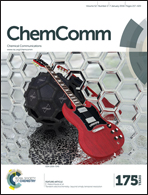Unexpected higher stabilisation of two classical antiaromatic frameworks with a ruthenium fragment compared to the osmium counterpart: origin probed by DFT calculations†
Abstract
Density functional theory (DFT) calculations were carried out to investigate the stability and aromaticity of metallapentalocyclobutadienes. The results reveal unexpected higher stabilisation achieved with a 3d ruthenium fragment compared to the 4d osmium counterpart. Moreover, direct 1–3 metal–carbon bonding in the metallabutadiene unit of these two complexes is negligible.


 Please wait while we load your content...
Please wait while we load your content...